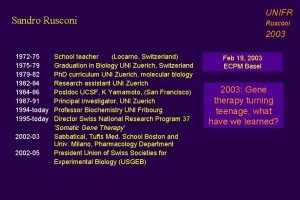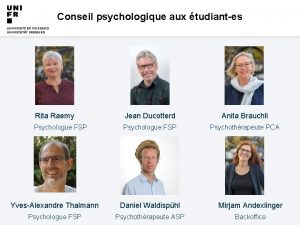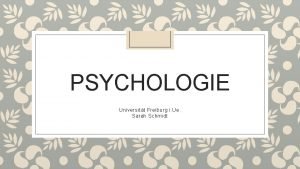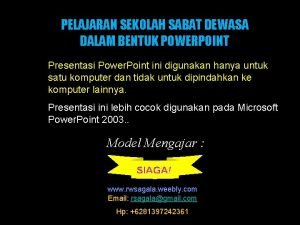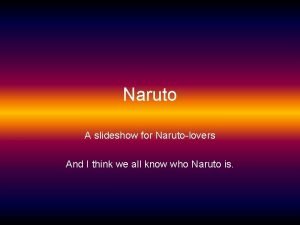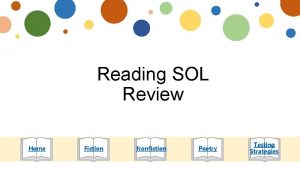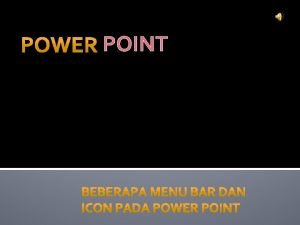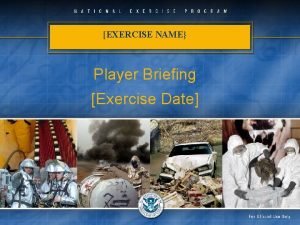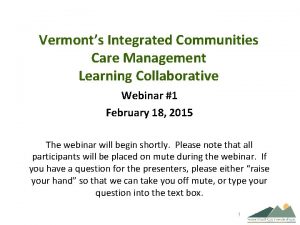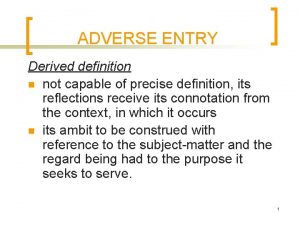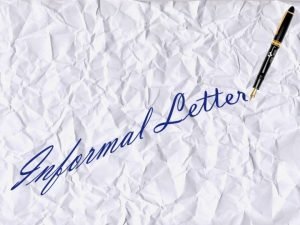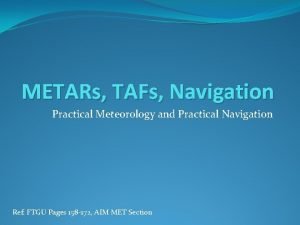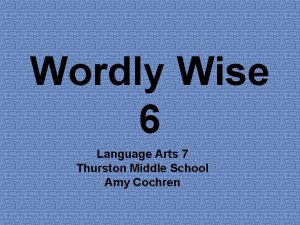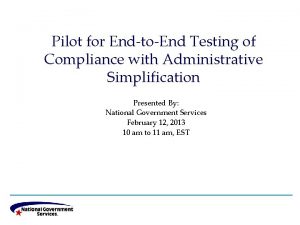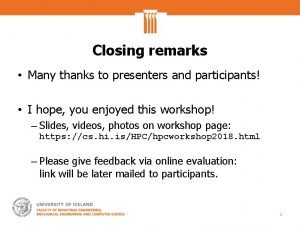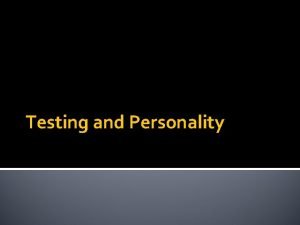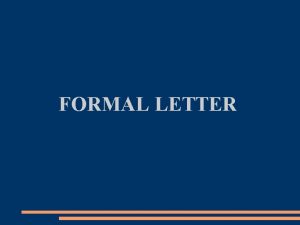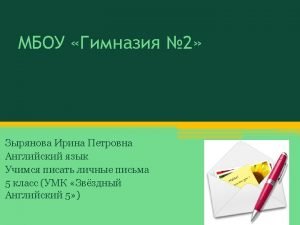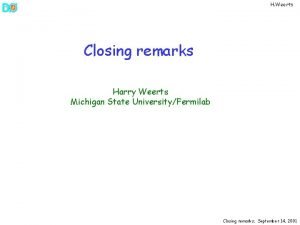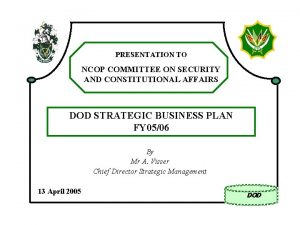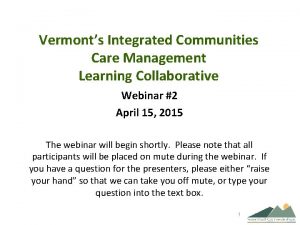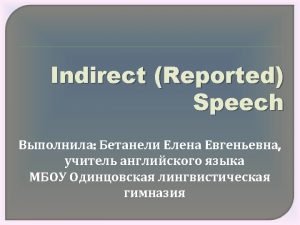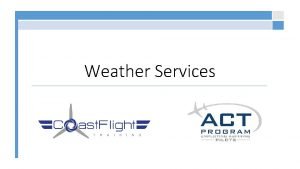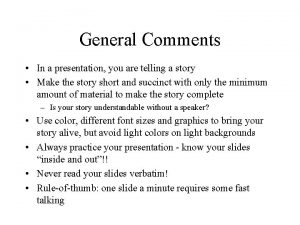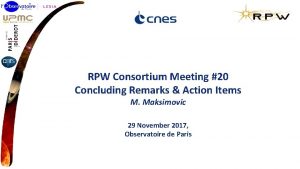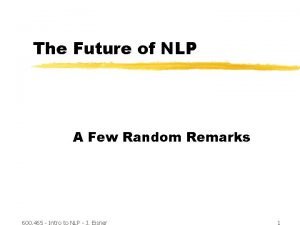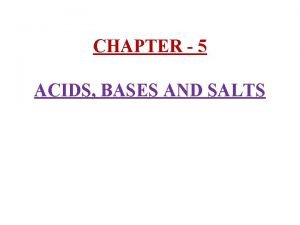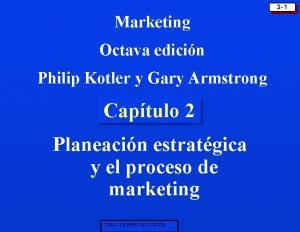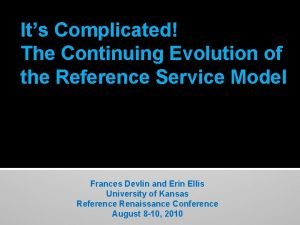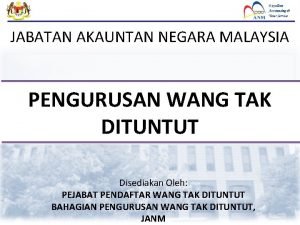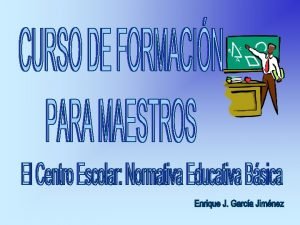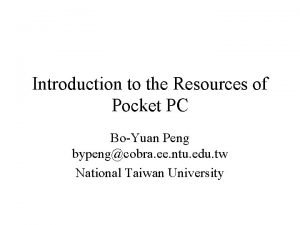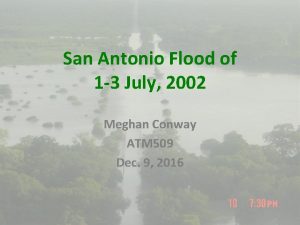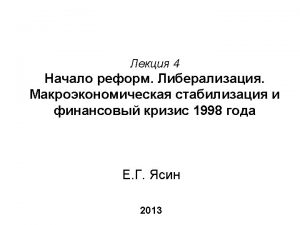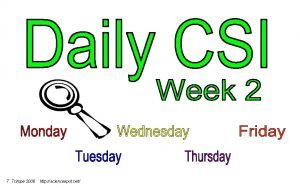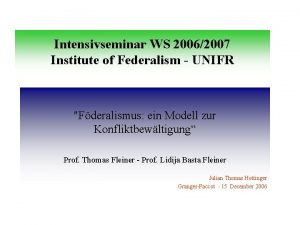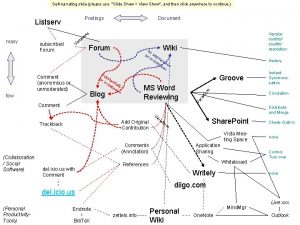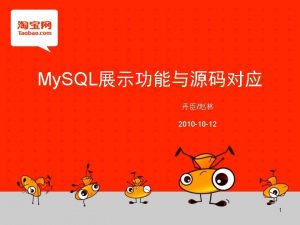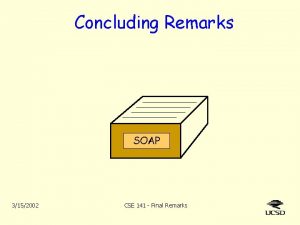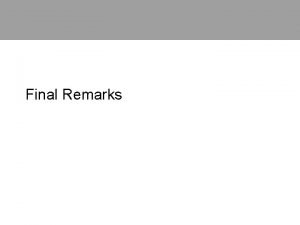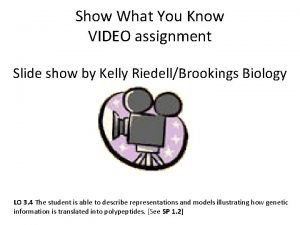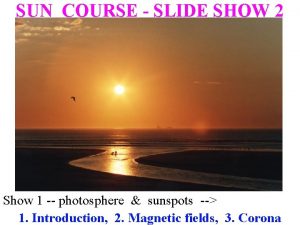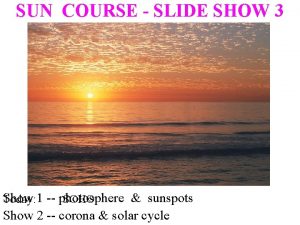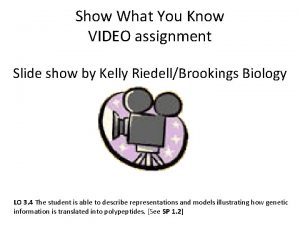UNIFR Technical Remarks Rusconi 2002 This slide show












































- Slides: 44

UNIFR Technical Remarks Rusconi 2002 This slide show was prepared with Power Point 98 for Macintosh therefore, 'thank' to the limited portability it may halt or improperly display on windows-based machines. This is not due to our bad will but to the sloppiness of software suppliers who are apparently unable to produce a platform that is genuinely interchangeable in the third millenium ! This is an internet-streamlined version (without heavy graphics or movies). The movie clips listed below accompany the full slide show Please write to: sandro. rusconi@unifr. ch to get the full size document. sru. Ski 2. mov genet walk on DNA. mov sport boxe 01. mov aa getting oldcomp 2. mov molecular_therapycardio 1. mov sport GIRO 98. MOV sport football 01. mov sport maradona 01. mov sport motorbike 01. mov sport snowboard slalom. mov sport hunter jones. mov sport weigh women 2. mov sport sydney 2000. mov sport weights advert. mov iceage. sub. mov The slide show will display better if your machine has sufficient live memory and a speedy processor S. Rusconi

Sandro Rusconi UNIFR Rusconi 2002 1972 -75 1975 -79 1979 -82 1982 -84 1984 -86 1987 -91 1994 -today 1996 -today 2001 2002 Primary school teacher (Locarno, Switzerland) Graduation in Biology UNI Zuerich, Switzerland Ph. D curriculum UNI Zuerich, molecular biology Research assistant UNI Zuerich Postdoc UCSF, K Yamamoto, (San Francisco) Principal Investigator, UNI Zuerich (mol. bio. ) Professor Biochemistry UNI Fribourg Director Swiss National Research Program 37 'Somatic Gene Therapy' Participant Swiss Natl. Res Program 50 'Endocrine disruptors' Sabbatical, Tufts Med. School Boston and Univ. Milano, Pharmacology Department President Union of Swiss Societies for Experimental Biology (USGEB) Bern, Nov 22, 2002 Swiss Olympic gene doping workshop Sports doping: Is there a realistic application for gene transfer?

Schedule Basic understanding of 'genes': what is a gene, how many genes, molecular biology dogma genetic diseases, environmental factors, ageing Essential concepts on 'molecular medicine' & molecular doping: applications and problems, Techniques of gene transfer (Gene Therapy) problems and solutions, vectors, clinical achievements Gene-based doping applications, comparison with other doping, detection Conclusions plausibility table UNIFR Rusconi 2002

Genetics has been used since millennia, Molecular Biology, only since 30 years 100’ 000 b. C. Empirical genetics 10’ 000 b. C. Biotechnology 2000 a. d. Molecular biology 2001 a. d, Genomics UNIFR Rusconi 2001

UNIFR 1 Gene -> 1 or more functions DNA RNA Transcription / translation Rusconi 2001 Protein Gene expression GENE 2 -5 FUNCTIONS 100 ’ 000 genes (50 ’ 000 genes? ) >300 ’ 000 functions (>150 ’ 000 functions)

What is in fact a gene? : a segment of DNA acting as a regulated machine for RNA production DNA GENE RNA Protein Transcription / translation FUNCTION RNA DNA spacer regulatory coding spacer UNIFR Rusconi 2002

UNIFR 1 Organism -> more than 105 genetically-controlled Functions Rusconi 2002 2 mm 2 m 0. 2 mm 0. 001 mm DNA RNA Protein

Reductionistic molecular biology paradigm (gene defects and gene transfer) DNA Protein GENE FUNCTION(s) GENE OK FUNCTION OK GENE KO FUNCTION KO GENE transfer FUNCTION transfer UNIFR Rusconi 2002

Gene amplification / manipulation techniques (genetic engineering, recombinant DNA) segments of genomic DNA can be specifically cut and isolated segment can be recombined with a plasmid vector Science-grade material can be essentially prepared in your cellar plasmid vector is transferred into bacteria where it can multiply . . . not so clinical-grade material! isolated recombinant DNA can be further recombined to obtain the final desired molecule Final molecule is transferred into cells or organisms UNIFR Rusconi 2002

UNIFR The FOUR eras of molecular medicine Eighties Genes as probes Nineties Genes as factories Rusconi 2002 Y 2 K Genes as drugs 1 2 3 4 5 ok ** ** 50 10 3000 80 85 90 95 99 1000 Y 2 K+n Post-genomic improvements of former technologies 80 85 90 95 00

UNIFR Rusconi 2002 100% 10 1 many treatments that slow down ageing 4 or age-related degenerative diseases are also potential doping treatments 20 40 60 80 80 70 60 1900 20 40 60 50 1900 100 Alzheimer’s free % Life expectancy (CH) cancer incidence The major disease of the 21 st century: Ageing 1920 1940 1960 1980 199 1900 E 2/E M E 3/E 4 E 4/E 4 80 2000

Now, let's talk about Somatic Gene Therapy (somatic gene transfer) Definition of GT: 'Use genes as drugs': Correcting disorders by somatic gene transfer NFP 37 somatic gene therapy www. unifr. ch/nfp 37 Chronic treatment Acute treatment Preventive treatment Hereditary disorders Acquired disorders Loss-of-function Gain-of-function UNIFR Rusconi 2002

Somatic gene therapy’s (gene transfer) four fundamental questions Efficiency of gene transfer Specificity of gene transfer Persistence of gene transfer Toxicity of gene transfer UNIFR Rusconi 2002 Remember!

Why 'somatic'? UNIFR Rusconi 2001 l Germ Line Cells: the cells (and their precursors) that upon fertilisation can give rise to a descendant organism i. e. somatic gene transfer is a treatment aiming at somatic cells and consequently does not lead to a hereditary transmission of the genetic alteration l Somatic Cells: all the other cells of the body

UNIFR Rusconi 2001 Pharmacological considerations Classical Drugs Protein Drugs Nucleic Acids OH Mw 50 - 500 Daltons l Mw 20 ’ 000 - 100 ’ 000 Da l Mw N x 1’ 000 Da OH l Synthetically prepared l Biologically prepared l Rapid diffusion/action l Slower diffusion/action l Slow diffusion l Oral delivery possible l Oral delivery not possible l Oral delivery inconceivable O l Cellular delivery: O OH OH - act at cell surface- act extracellularly - no membrane translocation - permeate cell membrane - no nuclear translocation - imported through channels - no biological import l O OH Can be delivered as l Must be delivered as OH soluble molecules complex carrier particles Ångstrom/nm size 50 -200 nm size O

THREE classes of physiological gene delivery Ex-vivo In-vivo topical delivery UNIFR Rusconi 2001 In-vivo systemic delivery V Examples: - bone marrow - liver cells - skin cells Examples: - brain - muscle - eye - joints - tumors Examples: - intravenous - intra-arterial - intra-peritoneal

TWO classes of gene transfer vehicles: non-viral & viral Non-viral transfer (transfection) Viral gene transfer (Infection) UNIFR Rusconi 2001 a b Nuclear envelope barrier! see, Nature Biotech December 2001

UNIFR Rusconi 2001 Transfection with recombinant DNA Vs Infection with recombinant viruses Transfection exposed to 106 particles/cell 12 hours Infection exposed to 3 particle/cell 30 min

Quick parade of popular vectors/methods Adenovirus Naked DNA Adeno-associated V. Liposomes & Co. Retrovirus (incl. HIV) Oligonucleotides UNIFR Rusconi 2002

UNIFR Rusconi 2002 Recombinant Adenoviruses Approaches Generation III Hybrid adenos: Adeno-RV l Adeno-AAV l Adeno-Transposase l Advantages / Limitations 8 Kb capacity Generation I >30 Kb capacity Generation III Adeno can be grown at very high titers, However l Do not integrate l Can contain RCAs l Are toxic /immunogenic Examples l OTC deficiency (clin, ---) l Cystic Fibrosis (clin, --- ) l Oncolytic viruses (clin, +++)

Recombinant AAV (adeno-associated-virus) Approaches Helper-dependent production Helper independent production Advantages / Limitations Persistence in the genome permits longterm expression, high titers are easily obtained, immunogenicity is very low, However the major problem is: l Cis-complementing vectors Co-infection UNIFR Rusconi 2002 Small capacity (<4. 5 kb) which does not allow to accommodate large genes or gene clusters. Examples l Hemophilia A (clin, animal, +++) l Gaucher (clin, animal, +++) l Brain Ischemia (animal, +++) l Cystic fibrosis (animal, +/-)

Recombinant Retroviruses (includes HIV-based) Approaches Murine Retroviruses VSV-pseudotyped RV Lentiviruses ! Self-inactivating RV Combination viruses UUNIFR Rusconi 2002 Advantages / Limitations 9 Kb capacity + integration through transposition also in quiescent cells (HIV), permit in principle long-term treatments, however disturbed by: l Insertional mutagenesis l Gene silencing l High mutation rate l Low titer of production Examples l SCID (IL 2 R defect, Paris) (clin, +++) l Adenosine Deaminase deficiency (clin, +++!!!) l Parkinson (preclin, +++) l Anti cancer (clin +/-)

UNIFR Rusconi 2002 Naked / complexed DNA Approaches Naked DNA injection /biolistic Naked DNA + pressure Naked DNA + electroporation Liposomal formulations Combinations Advantages / Limitations Unlimited size capacity + lower immunogenicity and lower bio-risk of non viral formulations is disturbed by l Low efficiency of gene transfer l Even lower stable integration Examples l Critical limb Ischemia (clin, +++) l Cardiac Ischemia (clin, +/-) l Vaccination (clin, +/-) l Anti restenosis (preclin. +/-)

UNIFR Rusconi 2002 Oligo-nucleotides Approaches Antisense Ribozymes/DNAzymes Advantages / Limitations these procedures may be suitable for : l handling dominant defects l transient treatments (gene modulation) l permanent treatments (gene correction) Triple helix Decoy / competitors Gene-correcting oligos Examples l Anti cancer (clin, preclin. , +/-) l Restenosis (clin, +++) l Muscular Distrophy (animal, +++) √ !

UNIFR Rusconi 2002 Recap: current limitations of popular gene transfer vectors Adenovirus - no persistence - limited packaging - toxicity - immunogenicity Retrovirus (incl. HIV) - limited package - random insertion - unstable genome General - antibody response - limited packaging - gene silencing Solutions: - synthetic viruses (“Virosomes”) Biolistic bombardment or local direct injection - limited area Electroporation - limited organ access Liposomes, gene correction & Co. - very inefficient transfer General - low transfer efficiency 1/10’ 000 of viruses’ in vivo Solutions: - improved liposomes with viral properties (“Virosomes”)

The most feared potential side-effects of gene transfer UNIFR Rusconi 2002 l Immune response to vector l immune response to new or foreign gene product l General toxicity of viral vectors l Adventitious contaminants in recombinant viruses l l Random integration in genome -> insertional mutagenesis (-> cancer risk) Contamination of germ line cells

UNIFR Gene Therapy in the clinic: Trials Wordldwide Rusconi 2002 trials patients As of Sept. 2002: 100 80 599 registered protocols 1500 4000 treated patients cancer 60 hered. 40 86% phase I 13% phase II 1 % phase III 500 vasc. 21% overall still pending Infect. or not yet Initiated ! 20 www. wiley. com 1990 1992 1000 1994 1996 1998 2000

Gene Therapy Milestones UNIFR Rusconi 2002 Anderson, 1990, 1993, 2000 // ADA deficiency Isner, 1998 Dzau, 1999 F Anderson, M Blaese // C Bordignon Kmiec, 1999 Fischer, 2000 1997, 2000, Critical limb ischemia Dickson, 2000 J Isner († 4. 11. 2001), I Baumgartner, Circulation 1998 Aebischer, 2000 Kirn, 2001 1998, Restenosis V Dzau, HGT 1998 1999, Crigler Njiar (animal) C Steer, PNAS 1999 Clinical trials with ONYX-015, 2000, Hemophilia what we learned? M Kay, K High 2000, SCID (Review) A Fischer, Science April 2000 Bordignon, 2000 (ESGT, Stockholm) 2000, correction Apo E 4 (animal model) proves efficacy of the same protocol G. Dickson, ESGT congress, 7. 10. 2000 Stockholm 2000, correction Parkinson (animal model) P Aebischer, Science, Nov 2000 2001, ONYX oncolytic Viruses D Kirn (Gene Ther 8, p 89 -98)

Gene Therapy Adverse events: NY 1995 // UPenn 1999 // Paris 2002 UNIFR Rusconi 2002 NY May 5, 1995, R. Crystal: in a trial with adenovirus mediated gene transfer to treat cystic fibrosis (lung) one patient developed a mild pneumonia-like condition and recovered in two weeks. The trial was interrupted and many others were put on hold. UPenn, Sept. 19, 1999, J. Wilson: in a trial with adenovirus mediated gene transfer to treat OTC deficiency (liver) one patient (Jesse Gelsinger) died of a severe septic shock. Many trials were put on hold for several months (years). Paris, Oct 2, 2002, A Fischer: in a trial with retrovirus mediated gene transfer to treat SCID (bone marrow) one patient developed a leukemia-like condition. The trial has been suspended to clarify the issue of insertional mutagenesis, and some trials in US and Germany have been put on hold.

UNIFR Ups and Downs of Gene Therapy: a true roller coaster ride! Rusconi 2002 high mood A. Fischer lentivectors in clinics? M. Kay R. Crystal Adeno I V. Dzau C Bordignon J. Isner ADA AAV NIH Adeno III germline Motulski in mice? report Lentivectors Paris Ergo: in pre-clinic in spite of its respectable age, J. Wilson Low gene transfer is still in its infancy J. Gelsinger and still produces more controversies NFP 37 than clinical results 90 91 92 93 94 95 96 97 98 99 00 01 02

UNIFR Rusconi 2002 The THREE levels of doping + Before the competition (anabolic enhancers) 'Molecular treatments Application of the know-how in molecular genetics to doping During the competition (perfomance enhancers) + + After the competition (repair enhancers)

Which gene transfer approaches would be compatible with doping strategies l l ex vivo, hematopoietic tissue: erythropoietin? in vivo local (example muscle): metabolic enhancers, growth factors, muscular fiber changers in vivo local (example joints): pain reducers, inflammation inhibitors, recovery and repair factors in vivo systemic: anabolic factors, endocrine factors, pain killers UNIFR Rusconi 2002

Which are the objective current limitations in gene-based doping strategies Viral gene transfer l immune problems l limited readministration l general toxicity, genotoxicity Nonviral gene transfer l generally inefficient l lack of persistence, requires readministration Strategy-independent problems l laborious, not readily available l long term gene expression difficult to control l irreversible effects or permanent tagging UNIFR Rusconi 2002

Which side effects could be feared in gene-based doping strategies UNIFR Rusconi 2002 Short -mid term l l l Autoimmunity Hyperimmunity Toxic shock Long term Intrinsic to reckless application l Fibrosis (probably the biggest danger) l Cancer l malpractice (unsuitable l Conventional effects of vector/administration route) administered factors l non-clinical grade material l Inaccessibility to future gene (adventitious pathogens therapy interventions (immunity) or allergens) l lack of follow-up

Which detection methods would be (or not) evisageable for gene-based doping strategies l Antibody detection (viral antigens or other epitopes) l recombinant-nucleic acids detection (PCR) l recombinant protein detection (MALDI-TOF / proteomics) l Gene transfer may be anatomically difficult to detect (if locally administered) but leaves permanent genetic marking l the detection of nucleic acids cannot be performed in body fluids (except for systemically administered treatments) and might require specific tissue biopsy UNIFR Rusconi 2002

Final side-by-side comparison: gene-based doping versus drug- or protein-based doping Category Drug/protein Gene-based Rapidity of effects rapid slow Reversibility rapid slow/none UNIFR Rusconi 2002 Ergo: straightforward difficult The odds speak currently rather against the adoption of Complexity of treatm. simple complex gene-based doping, but this applies to common-sense clinical practice, Associated risks depends high and this aspect is not guaranteed in the doping field Dosage Detectability arduous 'straightforward'

. . . Thanks ! UNIFR Rusconi 2002 Swissolympics My collaborators at UNIFR Swiss National Research Foundation Thank you all for the attention, and. . . if you are too shy to ask send an e-mail to: sandro. rusconi@unifr. ch or visit: www. unifr. ch/nfp 37 Our own project/goal may indeed appear very small and harmless. . . This does not necessarily apply to its consequences. . .

discussion slides UNIFR Rusconi 2002

UNIFR Examples of inheritable gene defects Polygenic defects (‘ frequent ’) Type estimated min - max Rusconi 2002 genetics Diabetes poly 1 - 4 % Hyperurikemia Multi 2 - 15 % Monogenic defects estimated Glaucoma poly 1 - 2 % (‘ rare ’) min - max Displasia Multi 1 - 3 % Cystic fibrosis, muscular dystrophy Hypercolesterolemia Multi 1 - 5 % immodeficiencies, metabolic diseases, all together Syn-& Polydactyly poly 0. 1 - 1 % Hemophilia. . . 0. 4 - 0. 7% Congenital cardiac defects Multi 0. 5 - 0. 8 % Manic-depressive psychosis Multi 0. 4 - 3 % Predispositions Type Miopy poly 3 - 4 % Polycystic kidney poly 0. 1 - 1 % Multi Psoriasis Multi (*) Alzheimer 2 - 3 % Multi Schizofrenia Multi (*) Parkinson 0. 5 - 1 % Multi Scoliosis Multi (*) Breast cancer 3 - 5 % (*) Colon Carcinoma Multi (*) Obesity Multi (*) Alcolholism/ drug addiction Multi Sum of incidences (all defects) behaviour environment estimated min - max 7 1 4 0. 1 0. 5 - 27 % - 3 % - 8 % - 1 % - 2 % 3% min - max 32 - 83%

The long way to drug/procedure registration is the principal cause of financial burden, but we cannot avoid it year event costs U$D 0 Idea 0 2 Cell culture assays 0. 5 Mio 5 Pre-clinical tests animal models 2 Mio Clinical phase I 5 -20 patients verify side effects 6 Mio Clinical phase II 30 -100 patients dosis escalation 12 Mio Clinical Phase III >300 - 1000 patients multicentric double blind 80 Mio 7 10 15 16>> Registration / Availability UNIFR Rusconi 2002 This means: assuming 20% of new developments makes it to final registration, the average investment is 300 -500 Mio U$D for each approved drug/procedure

UNIFR Not only the genome determines the health status. . . genetics Muscle distrophy Familial Breast Cancer Sporadic Breast Cancer Lung Cancer Obesity Artherosclerosis Alzheimer Parkinson ’s Drug Abuse Homosexuality behaviour Rusconi 2002 environment

Recap: what is a virus ? -> A superbly efficient replicating machine UUNIFR Rusconi 2002 100 nm docking entry disassembly genome replication early genes exp capsid replication E L 1 L 2 assembly Spread standard viral genome Etc. . . late genes exp

Engineering of replication-defective, recombinant viruses (Principle) rp E L 1 L 2 UNIFR Rusconi 2002 rp Wild type genome X Normal target cells E E E Recombinant genome Virions E E Packaging cells Normal target cells R-Virions

UNIFR 'Classical' GT models and strategies Rusconi 2002 l l l l Disease ADA deficiency (Immunodeficiency) Cystic Fibrosis (Lung, Pancreas) Haemophilia B (Blood) SCID (Immunodeficiency) Limb ischaemia (Hands, Feet) Cardiac ischaemia (Heart) l l l l transferred function ADA normal gene (enzyme) CFTR gene (chlorine transporter) Factor IX gene (blood clotting factor IL 2 R gene (gamma-C receptor) VEGF gene (vascular promoter) l l Clinical Results 1990 F. Anderson, 2002 C. Bordignon no significant results in spite of several trials 1999 -2000 M. Kay and K. Horwitz l 2000 A. Fischer l 1998 J. Isner l 2000 J. Isner
 2003-1972
2003-1972 Conseil psychologique unifr
Conseil psychologique unifr Slidetodoc.com
Slidetodoc.com Heel and toe polka
Heel and toe polka Flugtag 1988
Flugtag 1988 Sabbath school lesson ppt
Sabbath school lesson ppt Slideshow naruto
Slideshow naruto During a slide show luis wants a picture to appear
During a slide show luis wants a picture to appear Slide todoc.com
Slide todoc.com Factoring trinomials slide and divide method
Factoring trinomials slide and divide method Remarks in exercise
Remarks in exercise Closing remarks examples
Closing remarks examples Adverse entry meaning
Adverse entry meaning Adress in letter
Adress in letter Metars tafs
Metars tafs Sabbath school welcome poems
Sabbath school welcome poems Did postema fulfill her chief aspiration
Did postema fulfill her chief aspiration Closing remarks for webinar
Closing remarks for webinar Closing remarks for thesis defense
Closing remarks for thesis defense Deped transmutation table
Deped transmutation table Cettina fills out a personality
Cettina fills out a personality Letter writing
Letter writing Eager learning algorithm example
Eager learning algorithm example Closing paragraph informal email
Closing paragraph informal email Harry weerts
Harry weerts What is weather depiction chart?
What is weather depiction chart? Remarks in action plan
Remarks in action plan Closing remarks for webinar
Closing remarks for webinar Birthday closing remarks
Birthday closing remarks Example of general comments
Example of general comments Winds aloft gfk
Winds aloft gfk Remarks for report card
Remarks for report card Rpw comment
Rpw comment Remarks adalah
Remarks adalah Random remarks
Random remarks Natural indicators
Natural indicators Kotler 2002
Kotler 2002 Anschutz 2002
Anschutz 2002 Bahagian pengurusan wang tak dituntut
Bahagian pengurusan wang tak dituntut Lopegce
Lopegce Pocket pc 2002 emulator
Pocket pc 2002 emulator San antonio flood 2002
San antonio flood 2002 1993 1994 1995
1993 1994 1995 T. trimpe 2006 http://sciencespot.net/
T. trimpe 2006 http://sciencespot.net/ Cc 2002
Cc 2002
